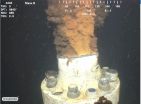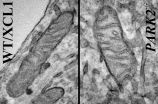(Press-News.org) Infants have innate knowledge about the world and when their expectations are defied, they learn best, researchers at Johns Hopkins University found.
In a paper to be published April 3 in the journal Science, cognitive psychologists Aimee E. Stahl and Lisa Feigenson demonstrate for the first time that babies learn new things by leveraging the core information they are born with. When something surprises a baby, like an object not behaving the way a baby expects it to, the baby not only focuses on that object, but ultimately learns more about it than from a similar yet predictable object.
"For young learners, the world is an incredibly complex place filled with dynamic stimuli. How do learners know what to focus on and learn more about, and what to ignore? Our research suggests that infants use what they already know about the world to form predictions. When these predictions are shown to be wrong, infants use this as a special opportunity for learning," said Feigenson, a professor of psychological and brain sciences in the university's Krieger School of Arts and Sciences. "When babies are surprised, they learn much better, as though they are taking the occasion to try to figure something out about their world."
The two researchers' study involved four experiments with preverbal 11-month-old babies, designed to determine whether babies learned more effectively about objects that defied their expectations. If they did, researchers wondered if babies would also seek out more information about surprising objects and if this exploration meant babies were trying to find explanations for the objects' strange behavior.
First the researchers showed the babies both surprising and predictable situations regarding an object. For instance, one group of infants saw a ball roll down a ramp and appear to be stopped by a wall in its path. Another group saw the ball roll down the ramp and appear to pass -- as if by magic -- right through the wall.
When the researchers gave the babies new information about the surprising ball, the babies learned significantly better. In fact, the infants showed no evidence of learning about the predictable ball. Furthermore, the researchers found that the babies chose to explore the ball that had defied their expectations, even more than toys that were brand new but had not done anything surprising.
The researchers found that the babies didn't just learn more about surprising objects -- they wanted to understand them. For instance, when the babies saw the surprising event in which the ball appeared to pass through the wall, they tested the ball's solidity by banging it on the table. But when babies saw a different surprising event, in which the ball appeared to hover in midair, they tested the ball's gravity by dropping it onto the floor. These results suggest that babies were testing specific hypotheses about the objects' surprising behavior.
"The infants' behaviors are not merely reflexive responses to the novelty of surprising outcomes, but instead reflect deeper attempts to learn about aspects of the world that failed to accord with expectations," said Stahl, the paper's lead author and a doctoral student in psychological and brain sciences.
"Infants are not only equipped with core knowledge about fundamental aspects of the world, but from early in their lives, they harness this knowledge to empower new learning."
INFORMATION:
The study was supported by the National Science Foundation Graduate Research Fellowship.
French physicist Jean Charles Athanase Peltier discovered a key concept necessary for thermoelectric (TE) temperature control in 1834. His findings were so significant, TE devices are now commonly referred to Peltier devices. Since his work, there have been steady advancements in materials and design. Despite the technological sophistication Peltier devices, they are still less energy efficient than traditional compressor/evaporation cooling.
In the 1960's, Peltier devices were primarily made from Bismuth-Telluride (Bi2Te3) or Antimony-Telluride (Sb2Te3) alloys and ...
MIAMI - A first-of-its-kind study observed how oil droplets are formed and measured their size under high pressure. They further simulated how the atomized oil spewing from the Macondo well reached the ocean's surface during the Deepwater Horizon accident. The findings from the University of Miami (UM) Rosenstiel School of Marine and Atmospheric Science and University of Western Australia research team suggest that the physical properties in deep water create a natural dispersion mechanism for oil droplets that generates a similar effect to the application of chemical ...
Binge-drinking during adolescence may perturb brain development at a critical time and leave lasting effects on genes and behavior that persist into adulthood.
The findings, by researchers at the University of Illinois at Chicago College of Medicine using an animal model, are reported online in the journal Neurobiology of Disease.
"This may be the mechanism through which adolescent binge-drinking increases the risk for psychiatric disorders, including alcoholism, in adulthood," says lead author Subhash Pandey, professor of psychiatry and director of neuroscience alcoholism ...
Irvine, Calif. -- A newly developed website provides parents and children with individualized information and support -- based on factors like coping style and levels of worry and fear -- to help lower anxiety before outpatient surgery in children, according to a pair of articles in the April issue of Anesthesia & Analgesia.
The papers report on the development of the "Web-based Tailored Intervention Preparation for Surgery" (WebTIPS) project, which provides information and strategies to help children and parents prepare for surgery and anesthesia. A preliminary evaluation ...
Based on research in fruit flies, it has long been suspected that the most common mutation linked to both sporadic and familial Parkinson's disease (PD) wreaks its havoc by altering the function of mitochondria in neurons that produce the neurotransmitter dopamine. Using stem cells derived from patients who have PD, scientist at the Buck Institute have confirmed that finding in human cells for the first time. In research published in the April 2nd early online edition of Stem Cell Reports, Buck researchers also provide a valuable tool for testing potential treatments ...
BOSTON -- Pseudogenes, a sub-class of long non-coding RNA (lncRNA) that developed from the genome's 20,000 protein-coding genes but lost the ability to produce proteins, have long been considered nothing more than genomic "junk." Yet the retention of these 20,000 mysterious remnants during evolution has suggested that they may in fact possess biological functions and contribute to the development of disease.
Now, a team led by investigators in the Cancer Research Institute at Beth Israel Deaconess Medical Center (BIDMC) has provided some of the first evidence that one ...
The ability to learn associations between events is critical for survival, but it has not been clear how different pieces of information stored in memory may be linked together by populations of neurons. In a study published April 2nd in Cell Reports, synchronous activation of distinct neuronal ensembles caused mice to artificially associate the memory of a foot shock with the unrelated memory of exploring a safe environment, triggering an increase in fear-related behavior when the mice were re-exposed to the non-threatening environment. The findings suggest that co-activated ...
(Boston)--Using patient-derived stem cells known as induced pluripotent stem cells (iPSC) to study the genetic lung/liver disease called alpha-1 antitrypsin (AAT) deficiency, researchers have for the first time created a disease signature that may help explain how abnormal protein leads to liver disease.
The study, which appears in Stem Cell Reports, also found that liver cells derived from AAT deficient iPSCs are more sensitive to drugs that cause liver toxicity than liver cells derived from normal iPSCs. This finding may ultimately lead to new treatments for the condition.
IPSC's ...
Capitalizing on a rare opportunity to thoroughly analyze a tumor from a lung cancer patient who had developed resistance to targeted drug treatment, UC San Francisco scientists identified a biological escape hatch that explains the resistance, and developed a strategy in mice for shutting it down.
In experiments that combined the drug the patient had taken with a second compound that blocks off this newly discovered resistance pathway, the researchers were able to durably wipe out cancer cells in mice implanted with cells from the drug-resistant tumor.
"Even in cancers ...
CANCER RESEARCH UK scientists have discovered that a vital self-destruct switch in cells is hijacked - making some pancreatic and non small cell lung cancers more aggressive, according to research published in Cancer Cell today (Thursday)*.
The team, from the Cancer Research UK Centre at the UCL (University College London) Cancer Institute, found that mutations in the KRAS gene interferes with protective self-destruct switches, known as TRAIL receptors, which usually help to kill potentially cancerous cells.
The research, carried out in cancer cells and mice, shows ...


